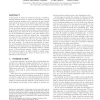MOBICOM
2006
ACM
14 years 6 months ago
2006
ACM
Underwater sensor networks consist of sensors and vehicles deployed to perform collaborative monitoring tasks over a given region. Underwater sensor networks will find applicatio...
MOBICOM
2006
ACM
14 years 6 months ago
2006
ACM
Wireless 802.11 hotspots have grown in an uncoordinated fashion with highly variable deployment densities. Such uncoordinated deployments, coupled with the difficulty of implemen...
MOBICOM
2006
ACM
14 years 6 months ago
2006
ACM
MOBICOM
2006
ACM
14 years 6 months ago
2006
ACM
In this paper, we consider the problem of mitigating interference and improving network capacity in wireless mesh networks from the angle of temporal-spatial diversity. In a nutsh...
MOBICOM
2006
ACM
14 years 6 months ago
2006
ACM
RFID tags are being used in many diverse applications in increasingly large numbers. These capabilities of these tags span from very dumb passive tags to smart active tags, with t...
MOBICOM
2006
ACM
14 years 6 months ago
2006
ACM
This paper presents a highly efficient and accurate link-quality measurement framework, called EAR (Efficient and Accurate link-quality monitoR), for multi-hop wireless mesh net...
MOBICOM
2006
ACM
14 years 6 months ago
2006
ACM
In this paper we study the broadcast capacity of multihop wireless networks which we define as the maximum rate at which broadcast packets can be generated in the network such th...
MOBICOM
2006
ACM
14 years 6 months ago
2006
ACM
Flash crowds and high concentrations of users in wireless LANs (WLANs) cause significant interference problems and unsustainable load at access points. This leads to poor connect...
MOBICOM
2006
ACM
14 years 6 months ago
2006
ACM
Determining node positions is essential for many next-generation network functionalities. Previous localization algorithms lack correctness guarantees or require network density h...
MOBICOM
2006
ACM
14 years 6 months ago
2006
ACM
It was recently reported that all known face and combined greedy-face routing variants cannot guarantee message delivery in arbitrary undirected planar graphs. The purpose of this...




